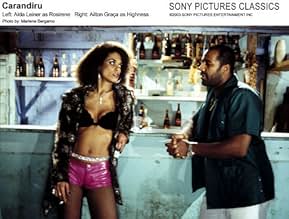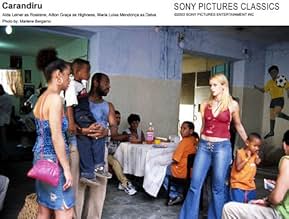El médico brasileño Drauzio Varella inicia la prevención del sida en la mayor cárcel de Brasil, Carandiru, en São Paulo, donde la población es casi el doble de la máxima.El médico brasileño Drauzio Varella inicia la prevención del sida en la mayor cárcel de Brasil, Carandiru, en São Paulo, donde la población es casi el doble de la máxima.El médico brasileño Drauzio Varella inicia la prevención del sida en la mayor cárcel de Brasil, Carandiru, en São Paulo, donde la población es casi el doble de la máxima.
- Dirección
- Guionistas
- Elenco
- Premios
- 16 premios ganados y 33 nominaciones en total
- Gilson
- (as Enrique Díaz)
- Rosirene
- (as Aída Leiner)
Opiniones destacadas
The film is being dubbed by some as "this year's City of God", but it's very different to last years Brazillian smash. Where 'City of God' had some very flashy direction and MTV-ized zip-bang editing, 'Carandiru' is pretty straight forward. The film still has some great direction though, Hector Babenco has a leisurely style (matched by his actual output, it's been 7 years since his last film, and nearly 20 since 'Ironweed'), allowing the story the space it needs to breathe but still picking up the pace to build tension. Ironically the only section of the film I didn't really like was the bit that was the most 'City of God'-like. When the doctor is dealing with his patients he asks each one what their story is, and sometimes it's a bit forced, just like in 'City of God' with the "now it's my turn to tell you my story".
Where it's very similar to 'City of God' is it's themes - it's essentially a humanist comedy with a moral edge, dealing with love, hate, revenge, innocence and betrayal. The cons are poor and murderous, but lovable at the same time. If this film and 'City of God' are to believed drug-dealing thieving murderers all have their hearts in the right place and are all okay guys who just took a wrong turn on the road.
There's a bit of a stink being kicked up at the moment on the imdb forum for 'Carandiru'. A lot of Brazillian's are posting, very upset with filmmakers consistently showing Brazil in a negative light. I think that although both films do have that slant to them, they have actually increased interested in the country, and even more so the countries film output, taking it to a global audience. If all Scottish films are to be believed we're all a bunch of Glasweigan Gangster Hardnuts or heroin-addicted thieving murderers too, so I fail to see what the fuss is about.
The director drives home the real point of the film in the last 20 minutes. The overcrowding and in-fighting finally erupts into a full-blown riot that results in the main characters block being taken over by the prisoners. A riot squad enters, and the ensuing rampage is one of the most graphic and genuinely shocking ever committed to film. Definitely not for the faint-of-heart. I remember seeing the prison riot being reported in the UK news, and being appalled at how crowded the prison was, and how a government could let it reach boiling point like that. The last 20 minutes really smacked that home, but with the closing shots of the prison finally being demolished in 2002 you feel like there was at least some sort of closure on the tragedy.
The story is harrowing, but heart-warming, and the acting (mostly from unknowns) is top rate. It's my favorite film of the year so far, but do beware the last 20 minutes, you won't leave the cinema feeling happy.
However, this is not the non-stop assault on the senses of grim violence you might expect. In fact, only the last twenty minutes or so of the film deal with the massacre at all and the film instead concentrates on a much more human aspect to the carnage. Focusing on the character of the Doctor as he tries to raise awareness of AIDs in the prison, it revolves around his day to day life as he chats casually with the inmates, learning of their hopes, fears and more often than not, their reason for being in the prison in the first place. These are stories that range from sad, to touching to outright hilarity and you soon find yourself absorbed in this world of offbeat criminals, so much so that when the violence does erupt, it is all the more shocking for it.
There are differences to the normal, US prison drama as well. I'm not sure how the Brazilians run their penitentiaries, but here there are no uniforms and they are allowed many of the comforts of home, along with free reign of the prison yard. But these are still drab conditions, with multiple inmates crammed into a single room, sweltering in the intense heat of the tropical summer. And ultimately, the prison is a community, made of genuine individuals, rather than clear cut prison stereotypes. This is a masterful film, one of my top movies of all time.
I knew this fact would be shown in Hector Babenco's film, but I could never imagine it would be so strongly illustrated. It's pure violence and the audience gets really astonished. Although it's really sad and we can't avoid being sorry for those deaths and suffering, it's impossible not to like the movie. It's excellent.
It's important to say that the invasion is not the only fact that is shown. Actually the book is based in Drauzio Varela's book. Mr. Varela is a doctor who worked in the jail helping the prisoners. The book, that is called "Estação Carandiru" (Carandiru station - because of the underground station that is nearby) is a success in Brazil.
27-year-old Rodrigo Santoro is one of the best actors we have in Brazil nowadays. His talent on Brazilian TV Series have guaranteed him good roles in films made in the country and recently he has started an international career, once he'll be in "Charlie's Angels 2". Some other good actors like Milton Gonçalves and Caio Blat add more positive points to the production. Some others, unknown up to now, showed they'll probably have much success in the future due to their talent, like Lázaro Ramos.
Argentinean Hector Babenco directed 'Carandiru' with a great sense of art, talent and made his film probably the best one of Brazilian cinema this year.
My rate 10/10
¿Sabías que…?
- TriviaDr. Dráuzio Varella wrote the original book at the encouragement of a patient he was treating for lymphatic cancer. That very patient happened to be Hector Babenco, who recovered and went on to direct the film adaptation.
- ErroresDuring the riot, as the inmates are running up the stairs of the cell block shortly after the riot squad has entered, one inmate can be seen wearing a T-Shirt of hip-hop group the Wu-Tang Clan. The group only formed in the year the riot took place (1992), and did not release their first widely available album (36 Chambers - Enter the Wu-Tang) until the following year. It is unlikely they would at this time have had a following in Brazil, nor would merchandise be available.
- Citas
Lady Di: I've come to take the test.
Médico - Physician: Please, take a seat. First, I'd like to ask you a few questions, Lady Di.
Lady Di: I've seen this movie before, doctor. I've never needed a blood transfusion and I never pierce my veins. The only drug I use is a joint now and then... when I watch TV or for a little romance.
Médico - Physician: And partners, how many?
Lady Di: Oh, about 2000.
- ConexionesFeatured in 2005 Glitter Awards (2005)
Selecciones populares
- How long is Carandiru?Con tecnología de Alexa
Detalles
- Fecha de lanzamiento
- Países de origen
- Sitio oficial
- Idioma
- También se conoce como
- Vzbura vo väznici Carandiru
- Locaciones de filmación
- Productoras
- Ver más créditos de la compañía en IMDbPro
Taquilla
- Presupuesto
- BRL 12,000,000 (estimado)
- Total en EE. UU. y Canadá
- USD 216,335
- Fin de semana de estreno en EE. UU. y Canadá
- USD 17,945
- 16 may 2004
- Total a nivel mundial
- USD 10,781,635
- Tiempo de ejecución2 horas 25 minutos
- Color
- Mezcla de sonido
- Relación de aspecto
- 1.85 : 1
Contribuir a esta página







































